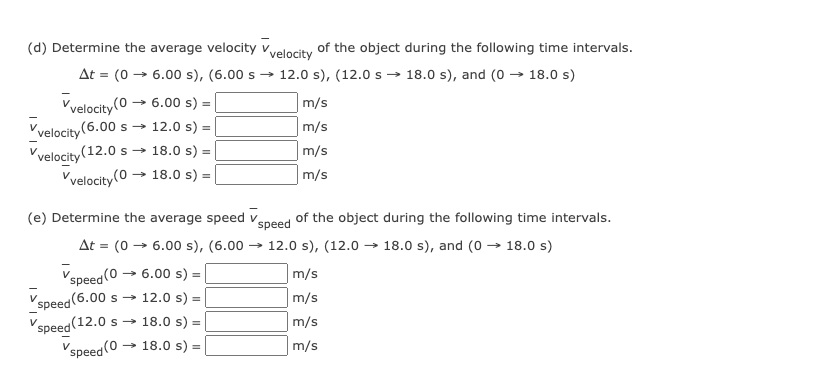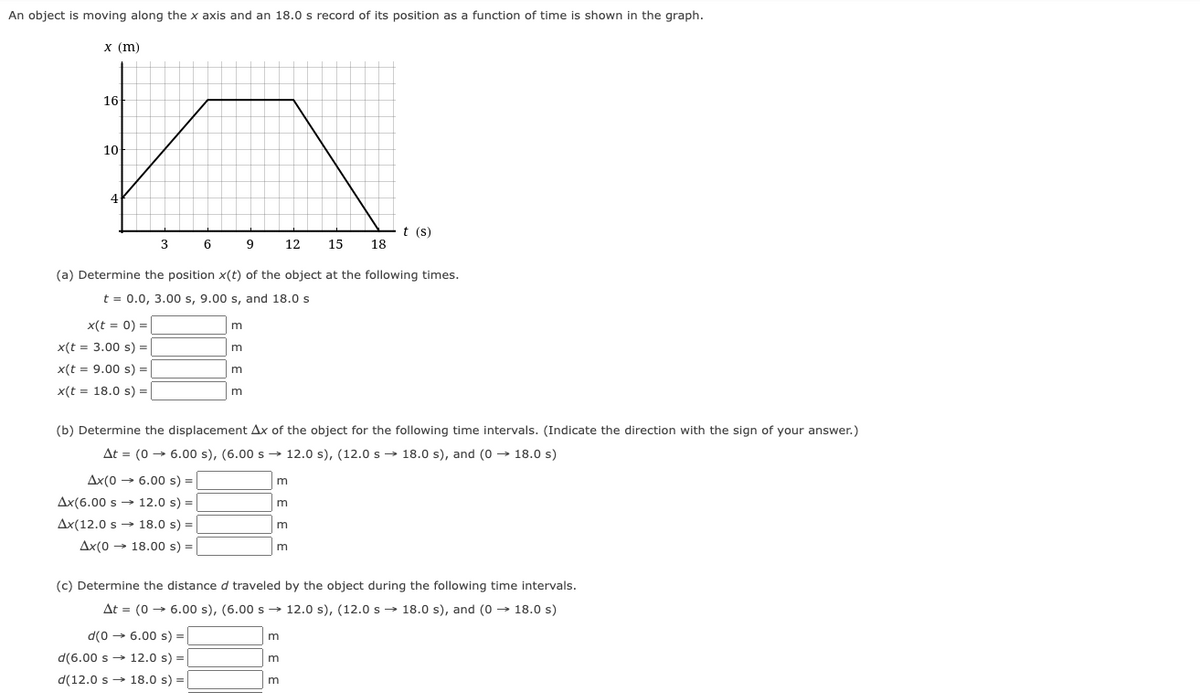An object is moving along the x axis and an 18.0 s record of its position as a function of time is shown in the graph. x (m) 16 10 4 t (s) 18 3 6 9 12 15 (a) Determine the position x(t) of the object at the following times. t = 0.0, 3.00 s, 9.00 s, and 18.0 s x(t = 0) =| x(t = 3.00 s) = x(t = 9.00 s) = %3D x(t = 18.0 s) = m (b) Determine the displacement Ax of the object for the following time intervals. (Indicate the direction with the sign of your answer.) At = (0 → 6.00 s), (6.00 s → 12.0 s), (12.0s - 18.0 s), and (0 → 18.0 s) %3D Ax(0 6. 00c)
An object is moving along the x axis and an 18.0 s record of its position as a function of time is shown in the graph. x (m) 16 10 4 t (s) 18 3 6 9 12 15 (a) Determine the position x(t) of the object at the following times. t = 0.0, 3.00 s, 9.00 s, and 18.0 s x(t = 0) =| x(t = 3.00 s) = x(t = 9.00 s) = %3D x(t = 18.0 s) = m (b) Determine the displacement Ax of the object for the following time intervals. (Indicate the direction with the sign of your answer.) At = (0 → 6.00 s), (6.00 s → 12.0 s), (12.0s - 18.0 s), and (0 → 18.0 s) %3D Ax(0 6. 00c)
Glencoe Physics: Principles and Problems, Student Edition
1st Edition
ISBN:9780078807213
Author:Paul W. Zitzewitz
Publisher:Paul W. Zitzewitz
Chapter6: Motion In Two Dimensions
Section6.3: Relative Velocity
Problem 27PP
Related questions
Question

Transcribed Image Text:(d) Determine the average velocity vyelocity of the object during the following time intervals.
At = (0 → 6.00 s), (6.00 s
12.0 s), (12.0 s → 18.0 s), and (0 → 18.0 s)
→ 6.00 s) =
m/s
Vvelocity(0
Vvelocity (6.00 s → 12.0 s) =
Vvelocity (12.0 s → 18.0 s) =
Vvelocity(0 → 18.0 s) =
m/s
m/s
|m/s
(e) Determine the average speed v.
speed
of the object during the following time intervals.
At = (0 → 6.00 s), (6.00
→ 12.0 s), (12.0 → 18.0 s), and (0 → 18.0 s)
Vspeed (0
6.00 s)
m/s
´speed(6.00 s → 12.0 s) =
(12.0 s → 18.0 s) =
m/s
S
m/s
speed
Vspeed(0 .
→ 18.0 s) =
m/s

Transcribed Image Text:An object is moving along the x axis and an 18.0 s record of its position as a function of time is shown in the graph.
х (m)
16
10
t (s)
3
12
15
18
(a) Determine the position x(t) of the object at the following times.
t = 0.0, 3.00 s, 9.00 s, and 18.0 s
x(t = 0) =
m
x(t = 3.00 s) =
x(t = 9.00 s) =|
m
x(t = 18.0 s) =
m
(b) Determine the displacement Ax of the object for the following time intervals. (Indicate the direction with the sign of your answer.)
At = (0 → 6.00 s), (6.00 s → 12.0 s), (12.0 s → 18.0 s), and (0 → 18.0 s)
Ax(0 → 6.00 s) =
Ax(6.00 s → 12.0 s) =
Ax(12.0 s → 18.0 s) =
Ax(0 → 18.00 s) =
(c) Determine the distance d traveled by the object during the following time intervals.
At = (0 → 6.00 s), (6.00 s → 12.0 s), (12.0 s → 18.0 s), and (0 → 18.0 s)
d(0 → 6.00 s) =
d(6.00 s → 12.0 s) =
m
d(12.0 s → 18.0 s) =
Expert Solution
This question has been solved!
Explore an expertly crafted, step-by-step solution for a thorough understanding of key concepts.
This is a popular solution!
Trending now
This is a popular solution!
Step by step
Solved in 2 steps

Knowledge Booster
Learn more about
Need a deep-dive on the concept behind this application? Look no further. Learn more about this topic, physics and related others by exploring similar questions and additional content below.Recommended textbooks for you

Glencoe Physics: Principles and Problems, Student…
Physics
ISBN:
9780078807213
Author:
Paul W. Zitzewitz
Publisher:
Glencoe/McGraw-Hill

Glencoe Physics: Principles and Problems, Student…
Physics
ISBN:
9780078807213
Author:
Paul W. Zitzewitz
Publisher:
Glencoe/McGraw-Hill